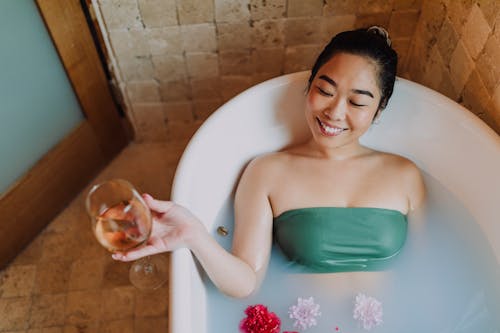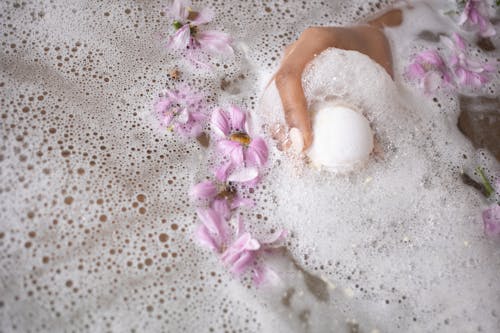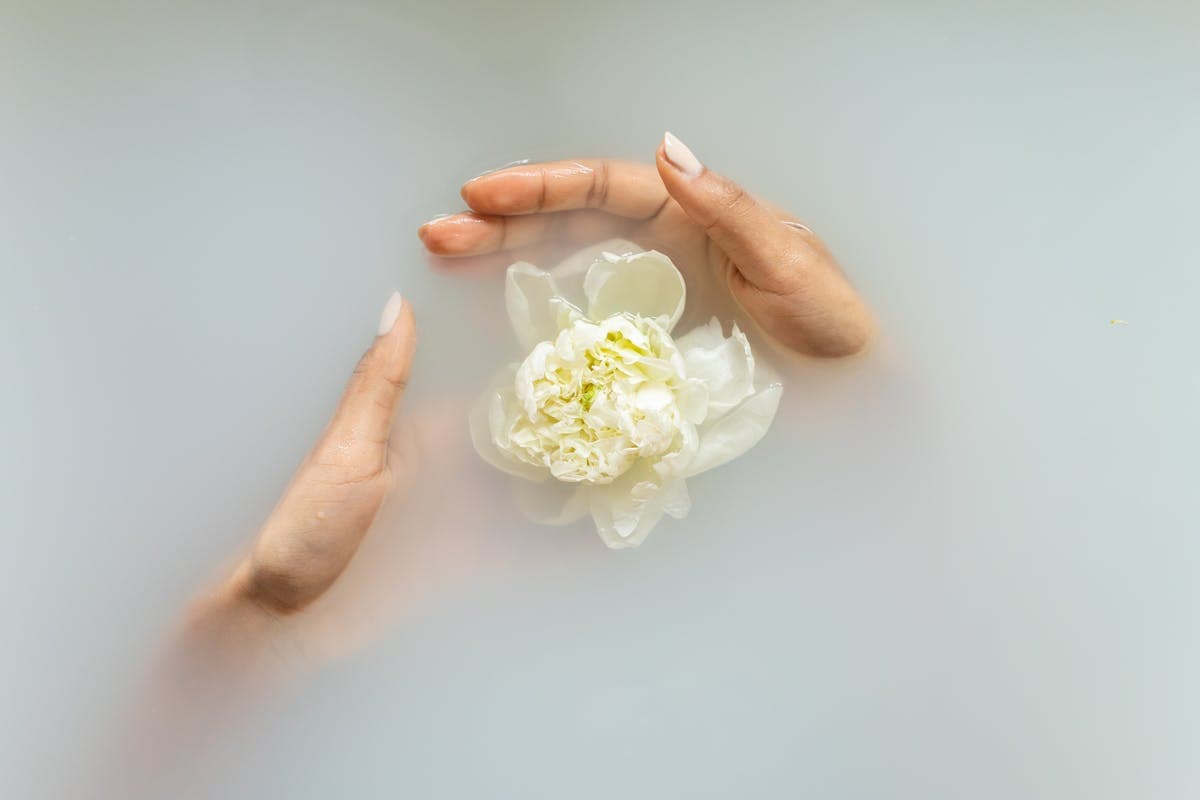An aromatherapy bath is a form of therapy that utilizes essential oils to enhance the bathing experience and promote overall well-being.
The use of essential oils in baths has been practiced for centuries and is known for its therapeutic benefits.
In this article, we will explore what an aromatherapy bath is, its benefits, different types of essential oils used, how to prepare for an aromatherapy bath, step-by-step guide to taking an aromatherapy bath, tips for enhancing your experience, precautions and safety measures, DIY aromatherapy bath recipes, where to find aromatherapy bath products, and finally,
answer some frequently asked questions.
Table of Contents
What is AN aromatherapy bath?

Aromatherapy is a natural relaxing method that benefits both physical and emotional well-being by employing essential oils in baths. Essential oils are concentrated plant extracts that are naturally scented and have medicinal qualities derived from the plants they are extracted from. These oils break into the water when added to a bath, releasing smells molecules that the body can absorb via the skin and breathe in. This makes it possible for the health benefits of the oils to affect the body and mind directly.
Benefits of aromatherapy bath
There are numerous benefits associated with aromatherapy baths. Firstly, it can help to relax and reduce stress. The soothing scents of essential oils can have a calming effect on the mind, helping to alleviate anxiety and promote relaxation. Additionally, certain essential oils have been found to have mood-enhancing properties, which can uplift your spirits and improve your overall well-being.
Furthermore, aromatherapy baths can also have physical benefits. Many essential oils have antiseptic, anti-inflammatory, and analgesic properties, which can help ease muscle tension, reduce pain, and promote healing. Some oils are also known for their skin-nourishing properties, making them excellent additions to your bath if you want to improve the health and appearance of your skin.
Lastly, an aromatherapy bath can be a form of self-care and a way to pamper yourself. Taking the time to create a relaxing and rejuvenating bath experience can be a great way to unwind and show yourself some love and care.
Different types of essential oils used in aromatherapy bath

There is a wide variety of essential oils that can be used in aromatherapy baths, each with its unique properties and benefits. Here are some commonly used essential oils for aromatherapy baths:
- Lavender: Known for its calming and relaxing properties, lavender oil is often used to promote sleep and reduce stress and anxiety.
- Eucalyptus: With its refreshing and invigorating scent, eucalyptus oil is commonly used to clear the sinuses and improve respiratory function.
- Peppermint: The cooling and soothing properties of peppermint oil make it great for relieving muscle aches and headaches.
- Rosemary: Known for its stimulating and invigorating properties, rosemary oil can help to improve focus and concentration.
- Chamomile: Chamomile oil is often used in aromatherapy baths to promote relaxation and relieve insomnia.
- Tea Tree: With its antibacterial and antifungal properties, tea tree oil can help to cleanse and purify the skin.
These are just a few examples, and there are many other essential oils available that can be used in aromatherapy baths. It’s important to choose oils that suit your personal preferences and address your specific needs.
How to prepare for an aromatherapy bath
Before taking an aromatherapy bath, it’s important to take a few steps to ensure a safe and enjoyable experience. Here’s how to prepare for an aromatherapy bath:
- Choose the right essential oil: Select an essential oil that suits your needs and preferences. Consider the therapeutic properties and scent of the oil.
- Dilute the essential oil: Essential oils are highly concentrated and should never be used directly on the skin. Dilute the oil with a carrier oil, such as jojoba or almond oil, before adding it to your bath.
- Gather your supplies: Prepare all the necessary supplies, including a clean bathtub, towels, and a timer.
- Create a relaxing atmosphere: Dim the lights, play soft music, and light some candles to create a soothing ambiance.
- Test the water temperature: Make sure the water is at a comfortable temperature before getting in. It should be warm, but not too hot.
- Cleanse your body: Take a quick shower before getting into the bath to ensure your body is clean.
- Turn off distractions: Put your phone on silent and eliminate any other distractions that may interfere with your relaxation.
By following these steps, you can create the perfect setting for your aromatherapy bath and fully enjoy its benefits.
Step-by-step guide to taking an aromatherapy bath

Now that you’re prepared for an aromatherapy bath, let’s go through a step-by-step guide on how to take one:
- Fill the bathtub: Fill the bathtub with warm water, making sure it’s at a comfortable temperature.
- Add the essential oil: Add a few drops of your chosen essential oil to the bathwater. The number of drops may vary depending on the oil and your personal preference. Start with a small amount and adjust as needed.
- Agitate the water: Use your hand or a bath brush to agitate the water and disperse the essential oil evenly.
- Get in and relax: Carefully step into the bath and immerse yourself in the water. Take a few moments to relax and enjoy the scent of the essential oils.
- Stay in the bath for 15-20 minutes: Allow yourself to soak in the bath for at least 15-20 minutes to fully experience the benefits of the essential oils.
- Rinse off: After your bath, rinse off the essential oil residue from your body under a warm shower. This will prevent any potential skin irritation.
- Pat dry and moisturize: Gently pat your skin dry with a towel and apply a moisturizer to lock in the hydration.
Remember to take your time and fully immerse yourself in the experience. Allow the aromas and sensations to relax and rejuvenate your body and mind.
Tips for enhancing your aromatherapy bath experience
To enhance your aromatherapy bath experience, consider the following tips:
- Experiment with different essential oils: Don’t be afraid to try different essential oils and combinations to find your favorite scents and therapeutic benefits.
- Use bath salts or bubbles: Adding bath salts or bubbles can enhance the relaxation and therapeutic effects of your aromatherapy bath.
- Practice deep breathing: Take deep breaths while in the bath to fully inhale the aromatic molecules of the essential oils.
- Set intentions or affirmations: Use your bath time to set intentions or repeat positive affirmations to further enhance the mental and emotional benefits.
- Incorporate meditation or visualization: Combine your aromatherapy bath with meditation or visualization techniques to deepen your relaxation experience.
- Take regular aromatherapy baths: Make aromatherapy baths a regular part of your self-care routine to reap the long-term benefits.
By incorporating these tips, you can elevate your aromatherapy bath experience and make the most out of it.
Precautions and safety measures for using essential oils in the bath
While aromatherapy baths can be highly beneficial, it’s important to take some precautions and follow safety measures to ensure a safe experience. Here are some guidelines to keep in mind:
- Always dilute the essential oils: As mentioned earlier, essential oils should never be used undiluted on the skin or in the bath. Dilute them with a carrier oil before use.
- Patch test for allergies: Before using a new essential oil, perform a patch test on a small area of your skin to check for any allergic reactions.
- Consult a healthcare professional: If you have any underlying health conditions or are pregnant, it’s best to consult a healthcare professional before using essential oils in the bath.
- Avoid sensitive areas: Keep essential oils away from your eyes, ears, and other sensitive areas. If any oil comes into contact with these areas, rinse immediately with clean water.
- Follow recommended dosages: Different essential oils have different recommended dosages. Follow the guidelines provided by reputable sources or consult an aromatherapist for proper usage.
- Store essential oils properly: Essential oils should be stored in dark glass bottles in a cool, dry place away from direct sunlight and heat.
By following these precautions and safety measures, you can enjoy your aromatherapy bath without any adverse effects.
DIY aromatherapy bath recipes
If you’re feeling adventurous, you can try creating your own DIY aromatherapy bath recipes. Here are a few simple recipes to get you started:
- Relaxing Lavender Bath:
- 10 drops of lavender essential oil
- 1 cup of Epsom salt
- Mix the lavender oil with the Epsom salt and add it to your bathwater. Relax and enjoy the calming scent of lavender.
- Energizing Citrus Bath:
- 5 drops of sweet orange essential oil
- 5 drops of grapefruit essential oil
- 5 drops of lemon essential oil
- Mix the citrus oils and add them to your bathwater. This invigorating blend will uplift your spirits and energize your body.
- Soothing Chamomile and Rose Bath:
- 5 drops of chamomile essential oil
- 5 drops of rose essential oil
- 1 tablespoon of carrier oil (such as jojoba or almond oil)
- Mix the essential oils with the carrier oil and add it to your bathwater. This soothing blend will help you relax and unwind.
Feel free to experiment with different essential oils and adjust the quantities based on your preferences. Get creative and tailor the recipes to suit your needs.
Aromatherapy bath products and where to find them
There are several aromatherapy bath products on the market if you prefer pre-made items. They are available from internet shops, health food stores, and beauty supply stores. Seek out trustworthy brands that employ premium essential oils and all-natural components. Bath salts, bath bombs, bath oils, and bubble baths are a few common aromatherapy bath products. To be sure you’re purchasing a product that suits your needs and preferences, read product labels and reviews.
Conclusion
An aromatherapy bath is a wonderful way to relax, rejuvenate, and promote overall well-being. By using essential oils in your bath, you can create a luxurious and therapeutic experience right in the comfort of your own home. Remember to choose the right essential oils, prepare for your bath, follow the step-by-step guide, and take precautions to ensure a safe and enjoyable experience. Whether you decide to create your DIY recipes or purchase ready-made products, an aromatherapy bath can be a valuable addition to your self-care routine.
Can I use multiple essential oils in my aromatherapy bath?
Yes, you can mix and match essential oils to create your desired scent and therapeutic benefits. Just make sure to follow recommended dosages and dilution guidelines.
How often should I take an aromatherapy bath?
The frequency of aromatherapy baths is a personal preference. Some people enjoy taking them daily, while others prefer a few times a week. Listen to your body and adjust accordingly.
Can I use essential oils directly in the bath without diluting them?
No, it’s important to always dilute essential oils before using them in the bath. Undiluted oils can cause skin irritation and other adverse effects.
Are there any essential oils to avoid in the bath?
Yes, some essential oils are known to be skin irritants or sensitizers. Examples include cinnamon, clove, and oregano oil. It’s best to research and consult with an aromatherapist before using any oil in your bath.
Can I take an aromatherapy bath if I’m pregnant?
While some essential oils are safe to use during pregnancy, others are not recommended. It’s best to consult with a healthcare professional before using essential oils in the bath during pregnancy.
Can I take an aromatherapy bath if I have sensitive skin?
If you have sensitive skin, it’s important to choose mild essential oils and perform a patch test before using them in the bath. Start with a small amount and observe any reactions.
Can children take aromatherapy baths?
Aromatherapy baths can be enjoyed by children, but it’s important to use child-safe essential oils and dilute them properly. Always supervise children during their baths.

